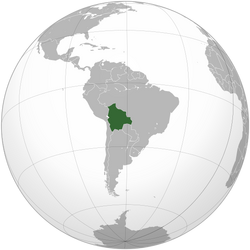|
Estado Plurinacional de Bolivia | |

|

|
| Motto "¡La unión es la fuerza!" | |
| Anthem Bolivianos, el hado propicio | |
| Capital | Sucre |
| Government | Presidential republic |
| President | |
| - From 2011 | Evo Morales |
| Legislature | Plurinational Legislative Assembly |
| - Upper house | Chamber of Senators |
| - Lower house | Chamber of Deputies |
| History | |
| - August 6, 1825 | Declared |
| - July 21, 1847 | Recognized |
| Area | 1,098,581 km² |
| Population | |
| - 2010 | 10,907,778 |
| Density | 9.9/km² |
| GDP | 2010 (PPP) |
| - Total | US$ 48.5 billion |
| - Per capita | US$ 4,451 |
| Currency | Boliviano |
| v | |
The Plurinational State of Bolivia is a presidential republic in South America.
Background
Bolivia, named after independence fighter Simon BOLIVAR, broke away from Spanish rule in 1825; much of its subsequent history has consisted of a series of nearly 200 coups and countercoups. Democratic civilian rule was established in 1982, but leaders have faced difficult problems of deep-seated poverty, social unrest, and illegal drug production. In December 2005, Bolivians elected Movement Toward Socialism leader Evo MORALES president - by the widest margin of any leader since the restoration of civilian rule in 1982 - after he ran on a promise to change the country's traditional political class and empower the nation's poor, indigenous majority. However, since taking office, his controversial strategies have exacerbated racial and economic tensions between the Amerindian populations of the Andean west and the non-indigenous communities of the eastern lowlands. In December 2009, President MORALES easily won reelection, and his party took control of the legislative branch of the government, which will allow him to continue his process of change.[1]
Economy
Bolivia is one of the poorest and least developed countries in Latin America. Following a disastrous economic crisis during the early 1980s, reforms spurred private investment, stimulated economic growth, and cut poverty rates in the 1990s. The period 2003-05 was characterized by political instability, racial tensions, and violent protests against plans - subsequently abandoned - to export Bolivia's newly discovered natural gas reserves to large northern hemisphere markets. In 2005, the government passed a controversial hydrocarbons law that imposed significantly higher royalties and required foreign firms then operating under risk-sharing contracts to surrender all production to the state energy company in exchange for a predetermined service fee. After higher prices for mining and hydrocarbons exports produced a fiscal surplus in 2008, the global recession in 2009 slowed growth. Nevertheless, Bolivia recorded the highest growth rate in South America that year. During 2010 an increase in world commodity prices resulted in the biggest trade surplus in history. However, a lack of foreign investment in the key sectors of mining and hydrocarbons and higher food prices pose challenges for the Bolivian economy.[2]
President
- Evo Morales (₩) (January 1, 2011 - )
Nation
Neighbouring Nations
References
- Bolivia: a country study (Library of Congress)
- Bolivia: a country study (archive.org)
- Bolivia: Guide to Law Online (Library of Congress)
- Bolivia: Location Map 2011 (UN OCHA, PNG)
- Bolivia: Maps (CIA)
- The World Factbook (CIA)
- Chiefs of State and Cabinet Members of Foreign Governments (CIA)
- U.S. Department of State
- Australian Government
- Inter-Parliamentary Union - Chamber of Senators
- Inter-Parliamentary Union - Chamber of Deputies
- BBC News Country Profile
- BBC News Time Line
- World Statesmen.org
- International Constitutional Law Project
- Psephos Election Archive
- Wikisource 1911 encyclopedia project
- Wikipedia
